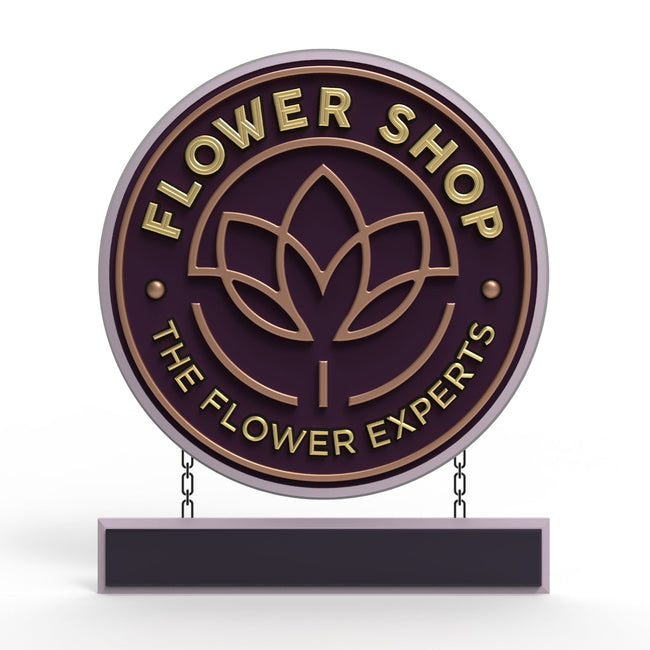Introduction
Shopping malls and indoor centres are unique environments where businesses compete for attention in a shared space. Unlike stand-alone storefronts, retailers inside malls must make the most of limited frontage while ensuring their signage is visible, professional, and memorable. Carved signs, known for their dimensional look and refined finish, are often associated with outdoor retail and hospitality settings. However, the question many business owners ask is: Do carved signs actually work in shopping malls and indoor centres?
The answer is yes, they can work very well, when applied strategically. Carved signs offer businesses an opportunity to stand out from the flat, mass-produced signage often found indoors. Their depth, texture, and craftsmanship create a sense of distinction that can appeal to shoppers who are surrounded by visual noise. At the same time, businesses must consider practical factors like lighting, placement, durability, and branding requirements within mall guidelines.
Do Carved Signs Work in Shopping Malls and Indoor Centres?
Carved signs have traditionally been used outdoors, on storefronts, restaurants, inns, and professional offices. Because their dimensional qualities help catch the eye from a distance. In indoor centres, however, their effectiveness depends on a blend of aesthetic, environmental, and logistical considerations. Below are the main points to consider:
1. Visual Impact in High-Traffic Areas
Indoor centres are designed to keep people moving. Shoppers often pass dozens of businesses in a short span, making it essential for signage to capture attention quickly. Carved signs stand out because they aren’t flat or generic; the engraved or raised lettering adds depth and shadow that draws the eye. In a sea of printed or backlit signs, a carved sign immediately communicates quality and individuality.
2. Reinforcing Brand Identity
Indoor malls often contain multiple stores in the same category—several clothing retailers, tech shops, or restaurants competing for attention. A carved sign can create an elevated brand impression by suggesting craftsmanship and permanence. For example, a boutique jeweler or specialty food shop might use a carved wooden or HDU (high-density urethane) sign to convey exclusivity and tradition, setting themselves apart from competitors using generic lightboxes.

3. Durability in Indoor Settings
Unlike outdoor environments, malls do not expose signs to harsh weather. This means carved signs indoors face fewer durability challenges, and the materials can maintain their appearance for years with minimal upkeep. HDU and wood finishes, when sealed, remain resilient under indoor lighting conditions and general wear-and-tear. Businesses benefit from long-term value without worrying about fading, cracking, or water damage.
4. Lighting Considerations
Carved signs inside malls often need supplemental lighting to achieve maximum effect. Shadows created by carved elements are less dramatic under flat indoor lighting compared to natural sunlight. Spotlights, downlights, or integrated LED fixtures can enhance the dimensional effect and highlight textures. Mall tenants should factor in the cost and permission requirements for additional lighting.
5. Mall Regulations and Guidelines
Most shopping centres have strict rules for signage, including size limits, mounting requirements, and aesthetic consistency. While some malls welcome unique and decorative signage, others require a uniform look across all units. Before investing in a carved sign, businesses should confirm whether their mall permits dimensional or textured signage. In many cases, carved signs can be adapted to meet size and mounting restrictions without losing their visual appeal.
6. Suitability by Business Type
Carved signs often work best for businesses that benefit from an upscale or artisanal feel. Examples include jewelers, craft retailers, spas, bookstores, coffee shops, and specialty food outlets. They may be less common for fast-fashion retailers or tech shops, where sleek and modern sign designs dominate. Understanding whether carved signs align with the business’s brand identity is crucial.
7. Cost and Value
Carved signs generally cost more upfront than flat printed or acrylic signage. However, in environments like malls where customers are seeking quality experiences, the investment can pay off in stronger brand recognition, improved foot traffic, and customer perception of value. For businesses positioned as premium or boutique, the return on investment can be significant.
FAQs (Frequently Asked Questions)
Q1: Are carved signs allowed in all shopping malls?
Not necessarily. Each mall sets its own signage guidelines, often detailed in tenant agreements. Some malls embrace individuality, while others enforce uniform signage to maintain a cohesive aesthetic. Business owners should always review mall policies before designing a carved sign.
Q2: Do carved signs require special lighting indoors?
Carved signs benefit from focused lighting to bring out their dimensional qualities. While ambient mall lighting may be sufficient, adding spotlights or integrated LEDs ensures the depth and texture are visible, enhancing the sign’s overall impact.
Q3: How long do carved signs last indoors?
When installed in an indoor centre, carved signs can last decades with minimal upkeep. Because they are not exposed to rain, UV rays, or temperature extremes, maintenance typically involves occasional dusting and cleaning rather than refinishing.
Q4: Are carved signs suitable for all business types inside malls?
Carved signs are particularly effective for businesses that want to communicate craftsmanship, tradition, or premium quality. They may not always be the best fit for businesses that want a highly modern or minimalist look, such as fast-fashion stores or tech retailers.
Q5: What materials are best for indoor carved signs?
High-density urethane (HDU) and wood are both popular choices. HDU is lightweight, durable, and easy to shape, while wood offers a classic, natural look. Since signs won’t face weather damage indoors, businesses can choose finishes that emphasize aesthetics without prioritizing extreme durability.
Q6: Are carved signs more expensive than other mall signage options?
Yes, carved signs typically cost more upfront compared to vinyl, acrylic, or flat-panel signs. However, the unique aesthetic and long lifespan often make them a worthwhile investment, particularly for businesses that want to emphasize distinction and long-term brand presence.
Conclusion
Carved signs can absolutely work in shopping malls and indoor centres, provided they align with the business’s brand identity and comply with mall regulations. Their dimensional qualities, durability, and ability to project quality make them an attractive option for retailers seeking to differentiate themselves from surrounding competitors. While the investment is higher than some alternatives, carved signs offer lasting value and visual distinction in crowded retail environments.
For businesses operating in malls, the key is to balance creativity with practicality: confirm mall guidelines, plan lighting carefully, and ensure the design communicates the right message. When executed thoughtfully, a carved sign doesn’t just mark a storefront—it becomes a brand statement that resonates with customers long after they leave the mall.
Getting high-quality 3D carved signs has never been this easy! We use only the highest quality material and paint finishes available for unmatched elegance and longevity. Check out Carved Signs and our outstanding sign collection. Just pick your style and customize it - we do the rest! Feel free to contact us online or call us at +1 (970)-455-8443.




